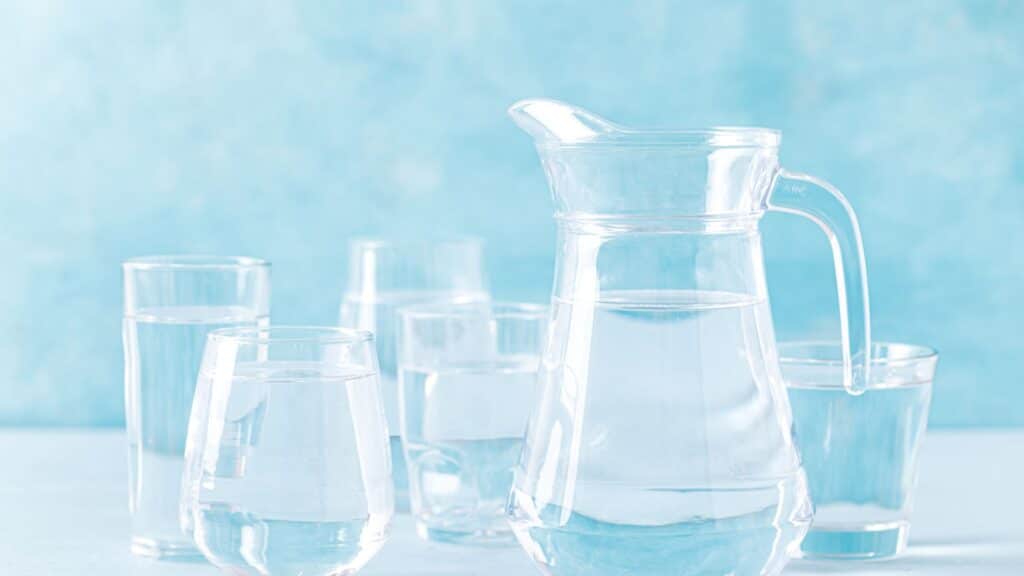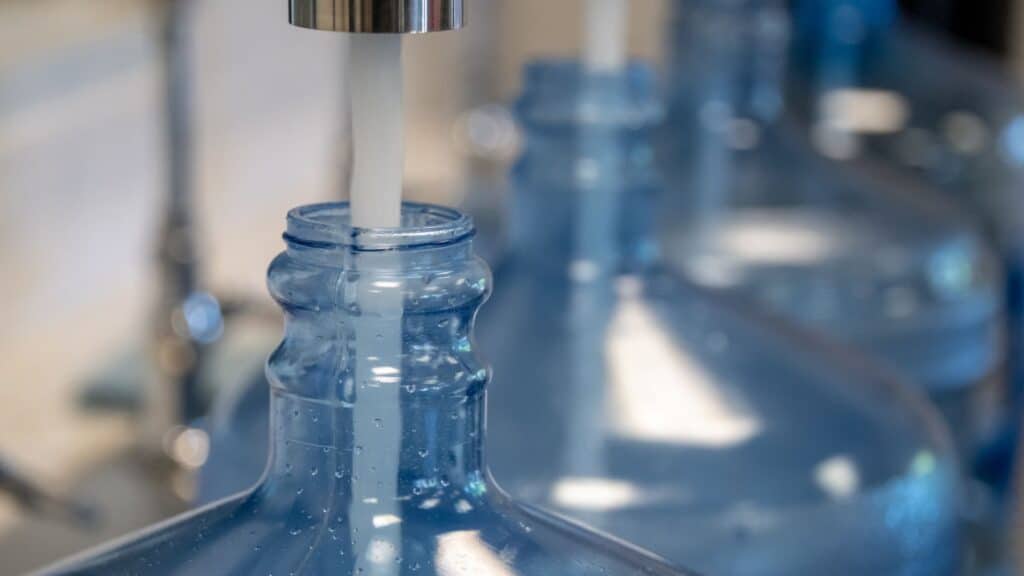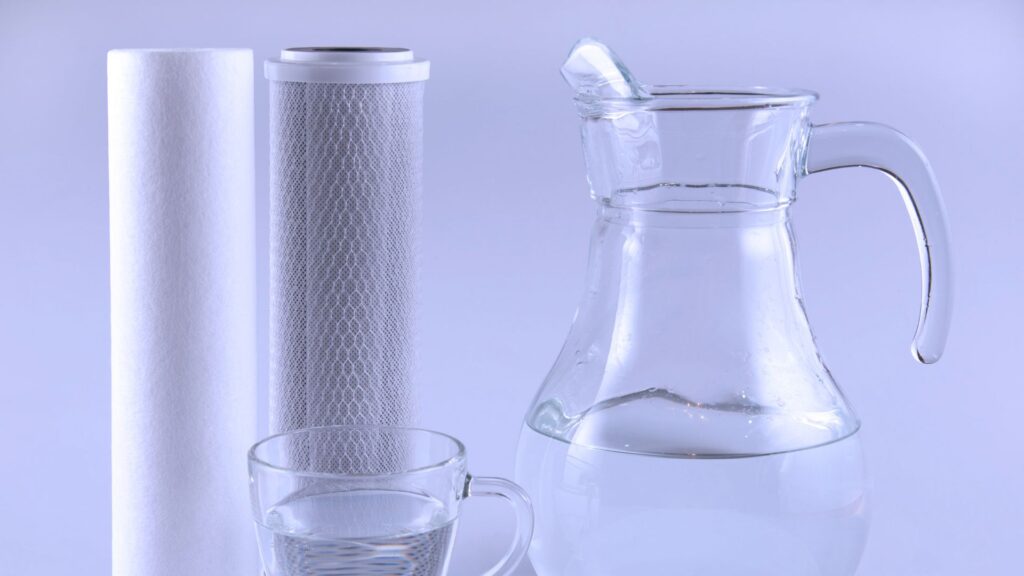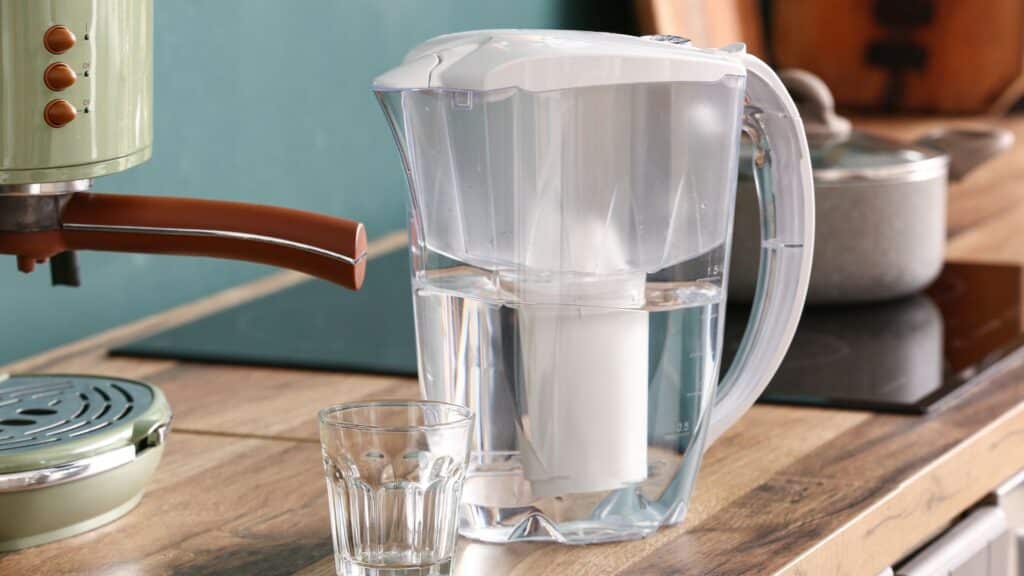Water is a fundamental part of our daily lives; we rely on it for hydration, cooking, and hygiene. However, not all water is created equal, and it’s essential to understand the differences between various types of purified water.
In this blog, we’ll explore the distinctions between distilled and purified water, their production methods, benefits, and drawbacks. We’ll also delve into the mineral content, taste, and environmental impact of each type of water, helping you decide which one is best for you.

What is Distilled Water?
Distilled water is purified water with contaminants and minerals removed through the purification process of distillation. This process involves boiling water, then collecting and condensing the steam back into a liquid form, resulting in water free of impurities, minerals, and other undesirable elements. The purification process effectively eliminates any contaminants, ensuring a high-quality and clean water source suitable for various applications.
How is Distilled Water Made?
The process of making distilled water is relatively simple yet effective in ensuring its purity. It involves the following steps:
Boiling:
The first step in producing distilled water is boiling the water. By heating the water to its boiling point (100°C or 212°F), it begins to evaporate, turning into steam. This process not only kills bacteria, viruses, and other microorganisms present in the water but also initiates the separation of water from its impurities.
Evaporation:
As the water evaporates and transforms into steam, it leaves behind impurities such as salts, minerals, and heavy metals, which have higher boiling points than water. The steam, consisting mainly of water molecules, rises and moves away from the source of impurities.
Condensation:
The next step is to cool down the steam and convert it back into its liquid state. This is done by passing the steam through a coiled tube or a condenser, where it loses heat and condenses back into liquid water. Since the steam is primarily composed of water molecules, the condensed liquid is now purified water, free from the impurities and minerals present in the original water source.
Collection:
Finally, the distilled water is collected in a separate container to prevent any contact with the impurities and minerals left behind in the boiling chamber. This ensures that the collected water maintains its high degree of purity.
Benefits of Distilled Water
Drinking distilled water, and only distilled water, has become a popular choice for individuals who prioritize their health and hydration. There are several reasons behind this preference:
Purity: Distilled water is free from impurities, such as salts, minerals, and heavy metals, that may be present in tap or spring water. This high degree of purity makes it an ideal choice for those who want to avoid consuming potentially harmful substances.
Reduced Contaminants: The distillation process effectively eliminates bacteria, viruses, and other microorganisms, ensuring that when you drink distilled water, it is clean and safe as possible.
Consistent Quality: Unlike tap water, which can vary in quality depending on the water source and local treatment methods, distilled water offers a consistent level of purity and quality wherever it is produced.
Improved Taste: Some people find that distilled water has a cleaner, more refreshing taste compared to tap or spring water, which can sometimes have a metallic or chlorine-like taste due to its mineral content and treatment methods.
Health Benefits: Drinking only distilled water can help reduce the risk of consuming harmful substances that may be present in other water sources, potentially leading to a healthier lifestyle.

Drawbacks of Distilled Water
Lack of Minerals:
Drinking distilled water may not be the best choice for everyone, as it lacks essential minerals such as calcium and magnesium, which are typically found in natural water sources. These minerals are crucial for maintaining good health.
Environmental Impact:
The distillation process consumes a significant amount of energy, which can contribute to increased carbon emissions and a larger environmental footprint. This makes some purification systems less eco-friendly than other alternatives.
Cost:
Distilled water can be more expensive than other types of purified water, such as filtered or spring water, due to the equipment and energy required for the distillation process. This may be a drawback for those concerned about the cost of their drinking water.
What is Purified Water?
Purified water has undergone a filtration or purification to remove impurities, contaminants, and dissolved minerals. These impurities may include bacteria, viruses, algae, fungi, heavy metals, and other pollutants. Purified bottled water is usually considered safer and cleaner than well or tap water and is commonly used for drinking, cooking, and other daily activities.
How is Purified Water Made?
Several methods are used to purify water, with the primary goal being the removal of impurities and contaminants. Some common purification methods include:
Filtration:
In the filtration process, water is passed through a material with a specific pore size, such as carbon or sediment filters, to capture and remove impurities. This process can target various contaminants, including sediment, chlorine, and organic compounds. Filtration is a common technique used in water treatment plants and home water purification systems. Filters come in various sizes and types, depending on the specific impurities targeted and the water quality desired.
Reverse Osmosis (RO):
Reverse Osmosis is a sophisticated water purification process where water is forced through a semi-permeable membrane under pressure. This thin membrane filters out contaminants and dissolved minerals like salts, heavy metals, and other particles down to the ionic level. Reverse Osmosis systems are commonly used for residential, commercial, and industrial applications for providing high-quality, purified drinking water.
Distillation:
Distillation is an ancient water purification method that involves boiling water and collecting the steam. As the liquid water converts into vapor, it leaves impurities and contaminants behind. The steam is then condensed back into liquid water, resulting in purified distilled water. This process can effectively remove bacteria, viruses, salts, metals, and other dissolved solids. While less energy-efficient than other treatment methods, distillation can produce very high-quality drinking water.
Ultraviolet (UV) Treatment:
Ultraviolet treatment employs UV light, a component of the sun’s radiation, to inactivate and destroy harmful microorganisms in the water. By utilizing specific wavelength ranges, most notably the 254-nanometer range, this purification method effectively targets bacteria, viruses, and certain parasites, preventing them from replicating and spreading. UV treatment is often used in combination with other filtration methods to ensure a comprehensive purification process. It is most effective when the water is already clear and free of sediment or other contaminants.
Ozonation:
Ozonation is a water treatment process where ozone gas (O3) is introduced into the water. As a powerful oxidant, ozone effectively neutralizes harmful substances, colors, and odors, breaking them down into simpler, less harmful compounds. Ozone can inactivate bacteria, viruses, and other pathogens, as well as oxidize iron, manganese, and other heavy metals. Once the ozone has completed its work, it rapidly decomposes back into regular oxygen (O2), leaving no harmful by-products. This environmentally friendly method is commonly employed in municipal and industrial water treatment settings.

Benefits of Using Purified Water:
Using purified water can offer a number of benefits, including:
Improved Taste:
When you drink purified water, you’re treating yourself to a superior taste experience compared to tap or well water. The purification process removes impurities and contaminants, resulting in a refreshing and satisfying drink that quenches your thirst like no other.
Health Benefits:
Choosing to drink purified water offers substantial health advantages. By eliminating harmful contaminants such as heavy metals and bacteria, you reduce the risk of exposure to illnesses and potential health issues. This clean, pure water promotes better overall well-being and keeps your body functioning optimally.
Consistency:
Another key benefit when you drink purified water is the consistency it offers. Whether you’re hydrating during a workout or enjoying a glass with dinner, purified water ensures a reliable and consistent quality and taste. This dependable water source is perfect for daily use, allowing you to stay refreshed and revitalized at all times.
Drawbacks of Using Purified Water:
Cost:
The process of purifying water can be expensive, especially if using bottled purified water or investing in a home purification system.
Environmental Impact:
The production and transportation of bottled purified water can contribute to pollution and the generation of plastic waste.
Potential Loss of Minerals:
Some purification methods, such as reverse osmosis and distillation, can remove natural minerals like calcium and magnesium, essential for good health.
Differences Between Distilled and Purified Water
Distilled and purified water are both forms of treated water that have undergone processes to remove impurities and contaminants. However, they differ in the methods used and the outcome.
Taste:
Distilled water is known for its bland taste, as the distillation process removes impurities and minerals that contribute to the water’s flavor. The absence of minerals can result in a flat and tasteless water profile. On the other hand, purified water maintains some of its mineral content, providing a more pleasant and refreshing taste than distilled water.

Mineral Content:
The primary difference between distilled and purified water lies in their mineral content. Distilled water undergoes distillation, which involves boiling and collecting the steam. This process removes virtually all minerals and impurities, resulting in almost 100% pure H2O water.
On the other hand, purified water can be produced through various methods such as reverse osmosis, carbon filtration, or ultraviolet (UV) disinfection. These processes remove impurities and contaminants but retain some minerals, giving purified water a higher mineral content than distilled water.
Health Benefits:
Both purified and distilled water are considered safe for consumption and have health benefits. Due to its lack of contaminants and minerals, distilled water is often preferred for use in medical facilities as it minimizes the risk of introducing foreign substances into sensitive environments. Additionally, distilled water may benefit individuals with specific dietary needs or sensitivities to certain minerals.
Purified water, while not as pure as distilled water, still offers numerous health benefits. It is free of harmful contaminants and pollutants, making it a safe and healthy choice for everyday consumption. The presence of essential minerals in purified water can help maintain proper electrolyte balance and support various bodily functions.
Applications and Uses:
Another significant difference between distilled water and purified water is their suitability for specific applications. Distilled water, due to its higher purity, is ideal for use in laboratories, medical facilities, and industries such as automotive and aerospace that require a high level of purity. It is also commonly used in situations where mineral deposits can cause damage, such as in steam irons and humidifiers.
Purified water, on the other hand, is more suitable for everyday use and consumption. It is widely used in homes, offices, and public spaces for drinking and cooking, as well as in various commercial applications such as food and beverage production, where water quality is crucial.
Distilled and purified water are both treated forms of water with varying degrees of purity. Distilled water is the purest form, devoid of minerals and impurities, making it ideal for sensitive applications. Purified water retains some mineral content, providing a more pleasant taste and making it suitable for general consumption and use. Understanding the differences between these two types of water can help you make informed decisions about their appropriate uses and potential health benefits.
Which Water is Right for Your Baby?
Selecting the ideal water for your baby is a critical decision, taking into account their age and unique requirements. Generally, tap water is deemed safe for infants over six months old, provided it has undergone testing and complies with the Safe Drinking Water Act standards.
For infants under six months or those with particular health issues, distilled or purified water might be advisable. Distilled water, devoid of minerals and contaminants, is a secure and trustworthy option for mixing baby formula or creating baby food.
Alternatively, purified water, acquired through methods like reverse osmosis or carbon filtration, can also be an appropriate choice for infants. Nevertheless, it is vital to confirm that the water has been sufficiently purified and adheres to the required drinking water standards.
In the end, the optimal water for your baby hinges on their personal needs and specific health concerns. It is always wise to seek advice from your pediatrician or a healthcare professional to determine the most suitable water source for your baby.

Expert Opinions and Recommendations
Expert opinions and recommendations are important to the topic and can provide valuable insights for parents or caregivers when deciding on the best water for baby formula. Here is a summary of the expert opinions and recommendations:
1. Pediatricians’ Perspectives
Pediatricians generally recommend using purified or distilled water for mixing liquid concentrate formula or powdered formula to ensure the water is free from contaminants.
They may also recommend using water fortified with essential minerals to support infants’ growth and development.
2. Insights From Baby Care Specialists
Baby care specialists often recommend using purified water designed for infants, as it is free from contaminants and contains the necessary minerals for healthy growth and development.
They may also suggest boiling tap water and letting it cool before mixing liquid concentrate formula or powdered formula as an alternative to purified or distilled water.

Practical Tips for Preparing Water for Baby Formula
When preparing water for babies, it’s crucial to prioritize their safety and well-being. Here are some practical tips to consider:
- Boil water before use: If using tap water or unsure about the safety of your water source, boil it for at least 1 minute and let it cool to room temperature before using it to mix formula powder or for any other baby-related purpose.
- Clean and sterilize containers: Ensure the containers you use to store mixed formula or prepared formula are clean. Wash them with hot soapy water, rinse thoroughly, and air dry before use.
- Store water in a cool, dark place: Store the prepared formula in a cool, dark place away from direct sunlight to prevent the growth of bacteria and other microorganisms.
- Use within 24 hours: Once you have prepared mixed formula, it is best to use it within 24 hours to ensure its freshness and safety. Discard unused formula afterward.
Bottled Water Recommendations
- Choose water designed for infants: Opt for bottled water specifically designed for infants, as it is free from contaminants and contains the necessary minerals for healthy growth and development.
- Check the label: Look for water that has been purified using methods like reverse osmosis, UV disinfection, or filtration. Ensure the water is low in sodium and fluoride, as high levels can harm infants.
- Examine the packaging: Choose water in BPA-free bottles to avoid potential exposure to harmful chemicals.
- Store bottled water properly: Keep bottled water in a cool, dark place away from direct sunlight, and follow the manufacturer’s guidelines for storage and expiration dates. Consider using low-fluoride bottled water for preparing your baby’s formula for added safety.
Precautions for Tap Water Usage
- Test your tap water: If you plan to use tap water for your baby, have it tested for contaminants, such as lead, bacteria, and nitrates. This can help you determine if additional filtration or purification is necessary for preparing the baby’s formula.
- Install a water filter: If your tap water contains contaminants, consider installing a certified water filter to remove the specific impurities in your water.
- Run the tap before use: When using tap water, run the tap for a few seconds before collecting the water to flush out any contaminants that may have accumulated in the pipes.
- Avoid using hot tap water: Do not use hot tap water for preparing water for baby formula, as it can contain higher contaminants. Always use cold tap water and heat it separately if needed.
- Consider low-fluoride bottled water: If you are concerned about tap water quality, low-fluoride bottled water can be a safer alternative for preparing your baby’s formula.
By following these practical tips and guidelines, you can ensure that the water you provide for your baby is safe, clean, and suitable for their needs.
Exploring the Use of Natural Spring Water for Babies
Natural spring water is another alternative to consider when choosing the right water for your little ones. Originating from an underground source and naturally filtered by the earth, spring water typically contains essential minerals like calcium, potassium, and magnesium, which are vital for your baby’s growth and development.
While they occur naturally, these minerals must still be balanced to ensure they don’t exceed safe levels for infants. Hence, not all spring water on the market is suitable for babies. Always choose spring water specially designed for infants. These are usually carefully sourced and processed to the highest standards, ensuring their safe mineral composition and absence of contaminants.
Moreover, natural spring water is generally considered crisp and fresh to the taste, which, over time, might make a difference in encouraging your little one to stay hydrated. However, it’s important to remember that even the purest natural source can be affected by environmental factors. Therefore, appropriate treatment, such as UV radiation or micron filtration, is applied to eliminate any potential contaminants, including bacteria or viruses.
There are also eco-friendly advantages to consider. The process of bottling natural spring water requires less filtration and thus less energy compared to purified water, leading to a smaller carbon footprint.
Taking into consideration the freshness, benefits of natural minerals, and the green aspect, spring water could be a suitable choice for your baby. Still, it’s essential to consult with pediatricians or healthcare professionals before making a switch to ensure it aligns with your baby’s health needs and dietary requirements.
While distilled and purified water are safe choices for your baby, exploring the option of natural spring water is valuable for its unique benefits. When it comes to deciding the best for your child, remember safety is paramount, and any decision should prioritize their health needs over anything else.
Conclusion
In conclusion, the differences between purified and distilled water are significant, and each type has benefits and drawbacks. Distilled water is 100% pure H2O, free from minerals and impurities, making it ideal for sensitive applications. On the other hand, purified water is treated through various filtration methods, retaining some of its mineral content and providing a better taste than distilled water.
While both types of water undergo processes to remove impurities and contaminants, they differ in mineral content, taste, environmental impact, and production costs. Ultimately, the choice between distilled and purified water comes down to personal preference and specific usage needs.
Did this article help you? We’d love to hear from you! Let us know if there’s anything we can do to make it better.



